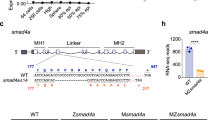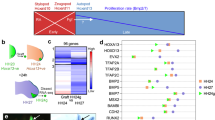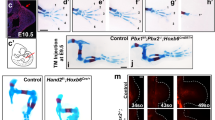Abstract
Outgrowth and patterning of the vertebrate limb are controlled by reciprocal interactions between the posterior mesenchyme (polarizing region) and a specialized ectodermal structure, the apical ectodermal ridge (AER)1. Sonic hedgehog (SHH) signalling by the polarizing region modulates fibroblast growth factor (FGF)4 signalling by the posterior AER, which in turn maintains the polarizing region (SHH/FGF4 feedback loop)2,3. Here we report that the secreted bone-morphogenetic-protein (BMP) antagonist Gremlin4 relays the SHH signal from the polarizing region to the AER. Mesenchymal Gremlin expression is lost in limb buds of mouse embryos homozygous for the limb deformity (ld) mutation, which disrupts establishment of the SHH/FGF4 feedback loop5,6,7. Grafting Gremlin-expressing cells into ld mutant limb buds rescues Fgf4 expression and restores the SHH/FGF4 feedback loop. Analysis of Shh-null mutant embryos8,9 reveals that SHH signalling is required for maintenance of Gremlin and Formin (the gene disrupted by the ld mutations)10,11. In contrast, Formin, Gremlin and Fgf4 activation are independent of SHH signalling. This study uncovers the cascade by which the SHH signal is relayed from the posterior mesenchyme to the AER and establishes that Formin-dependent activation of the BMP antagonist Gremlin is sufficient to induce Fgf4 and establish the SHH/FGF4 feedback loop.
This is a preview of subscription content, access via your institution
Access options
Subscribe to this journal
Receive 51 print issues and online access
$199.00 per year
only $3.90 per issue
Buy this article
- Purchase on Springer Link
- Instant access to full article PDF
Prices may be subject to local taxes which are calculated during checkout





Similar content being viewed by others
References
Johnson,R. L. & Tabin,C. J. Molecular models for vertebrate limb development. Cell 90, 979–990 (1997).
Laufer,E., Nelson,C. E., Johnson,R. L., Morgan,B. A. & Tabin,C. Sonic hedgehog and Fgf-4 act through a signalling cascade and feedback loop to integrate growth and patterning of the developing limb bud. Cell 79, 993–1003 (1994).
Niswander,L., Jeffrey,S., Martin,G. R. & Tickle,C. A positive feedback loop coordinates growth and patterning in the vertebrate limb. Nature 371, 609–612 (1994).
Hsu,D., Economides,A., Wang,X., Eimon,P. & Harland,R. The Xenopus dorsalizing factor Gremlin identifies a novel family of secreted proteins that antagonise BMP activities. Mol. Cell 1, 673–83 (1998).
Chan,D. C., Wynshaw-Boris,A. & Leder, P. Formin isoforms are differentially expressed in the mouse embryo and are required for normal expression of fgf-4 and shh in the limb bud. Development 121, 3151–3162 (1995).
Haramis,A. G., Brown,J. M. & Zeller,R. The limb deformity mutation disrupts the SHH/FGF-4 feedback loop and regulation of 5′HoxD genes during limb pattern formation. Development 121, 4237–4245 (1995).
Kuhlman,J. & Niswander,L. Limb deformity proteins: role in mesodermal induction of the apical ectodermal ridge. Development 124, 133–139 (1997).
Chiang,C. et al. Cyclopia and defective axial patterning in mice lacking Sonic hedgehog gene function. Nature 383, 407–413 (1996).
St-Jacques,B. et al. Sonic hedgehog signaling is essential for hair development. Curr. Biol. 8, 1058–1068 (1998).
Woychik,R. P., Maas,R. L., Zeller,R., Vogt,T. F. & Leder,P. ‘Formins’: Proteins deduced from the alternative transcripts of the limb deformity gene. Nature 346, 850–853 (1990).
Mass,R. L., Zeller,R., Woychik,R. P., Vogt,T. F. & Leder,P. Disruption of formin-encoding transcripts in two mutant limb deformity alleles. Nature 346, 853–855 (1990).
Zuniga,A. & Zeller,R. Gli3 (Xt) and formin (ld) participate in the positioning of the polarising region and control of posterior limb-bud identity. Development 126, 13–21 (1999).
Duprez,D., Fournier-Thibault,C. & LeDouarin,N. Sonic Hedgehog induces proliferation of committed skeletal muscle cells in the chick limb. Development 125, 495–505 (1998).
Marigo,V., Johnson,R. L., Vortkamp,A. & Tabin,C. J. Sonic hedgehog differentially regulates expression of GLI and GLI3 during limb development. Dev. Biol. 180, 273–283 (1996).
Marigo,V., Scott,M. P., Johnson,R. L., Goodrich,L. V. & Tabin,C. J. Conservation in hedgehog signaling: induction of a chicken patched homolog by Sonic hedgehog in the developing limb. Development 122, 1225–1233 (1996).
Trumpp,A., Blundell,P. A., de la Pompa,J. L. & Zeller,R. The chicken limb deformity gene encodes nuclear proteins expressed in specific cell types during morphogenesis. Genes Dev. 6, 14–28 (1992).
Zeller,R., Jackson-Grusby,L. & Leder,P. The limb deformity gene is required for apical ectodermal ridge differentiation and anterio posterior limb pattern formation. Genes Dev. 3, 1481–1492 (1989).
Duprez,D. M., Kostakopoulou,K., Francis-West,P. H., Tickle,C. & Brickell,P. M. Activation of Fgf-4 and HoxD gene expression by BMP-2 expressing cells in the developing chick limb. Development 122, 1821–1828 (1996).
Cho,K. & Blitz,I. BMPs, Smads and metalloproteases: extracellular and intracellular modes of negative regulation. Curr. Opin. Genet. Dev. 8, 443–449 (1998).
Pizette,S. & Niswander,L. BMPs negatively regulate structure and function of the limb apical ectodermal ridge. Development 126, 883–894 (1999).
McMahon,J. et al. Noggin-mediated antagonism of BMP signaling is required for growth and patterning of the neural tube and somite. Genes Dev. 12, 1438–1452 (1998).
Brunet,L., McMahon,J., McMahon,A. & Harland,R. Noggin, cartilage morphogenesis, and joint formation in the mammalian skeleton. Science 280, 1455–1457 (1998).
Lamb,T. et al. Neural induction by the secreted polypeptide noggin. Science 262, 713–718 (1993).
Francis,P. H., Richardson,M. K., Brickell, P M. & tickle,C. Bone morphogenetic proteins and a signalling pathway that controls patterning in the developing chick limb. Development 120, 209–218 (1994).
Hofmann,C., Luo,G., Balling,R. & Karsenty,G. Analysis of limb patterning in BMP-7-deficient mice. Dev. Genet. 19, 43–50 (1996).
Niswander,L. & Martin,G. R. FGF-4 and BMP-2 have opposite effects on limb growth. Nature 361, 68–71 (1993).
Fraidenraich,D., Lang,R. & Basilico,C. Distinct regulatory elements govern Fgf4 gene expression in the mouse blastocyst, myotome, and developing limb. Dev. Biol. 204, 197–209 (1998).
Nellen,D., Burke,R., Struhl,G. & Basler,K. Direct and long-range action of a DPP morphogen gradient. Cell 85, 357–368 (1996).
Lussier,M., Canoun,C., Ma,C., Sank,A. & Shuler,C. Interdigital soft tissue separation induced by retinoic acid in mouse limbs cultured in vitro. Int. J. Dev. Biol. 37, 555–564 (1993).
Ingham,P. Transducing Hedgehog: the story so far. EMBO J. 17, 3505–3511 (1998).
Acknowledgements
We thank G. Drossopoulu, M. Herlevsen and C. Tickle for advice in establishing the in vitro culturing system; T. Bouwmeester and S. Cohen for many stimulating discussions and support; C. McGuigan, B. Wagemakers and H. Goedemans for technical assistance; J. McMahon for breeding Shh-deficient mice; J. Jackson for mouse husbandry; D. Duprez, P. Brickell, H. Rohrer, R. Harland, T. Bouwmeester, S.-L. Ang and C. Niehrs for reagents; and G. Davidson, R. Dono, A. van Loon, P. Rørth and L. Panman for comments on the manuscript. This study was supported by EMBL and Utrecht University, grants from the European Community (to R.Z.), the NIH (to A.P.M.) and the Graduiertenkolleg “Experimentelle Nieren- und Kreislaufforschung” (to A.Z.).
Author information
Authors and Affiliations
Corresponding author
Rights and permissions
About this article
Cite this article
Zúñiga, A., Haramis, AP., McMahon, A. et al. Signal relay by BMP antagonism controls the SHH/FGF4 feedback loop in vertebrate limb buds. Nature 401, 598–602 (1999). https://doi.org/10.1038/44157
Received:
Accepted:
Issue Date:
DOI: https://doi.org/10.1038/44157
This article is cited by
-
Nicotine exacerbates diabetic nephropathy through upregulation of Grem1 expression
Molecular Medicine (2023)
-
Genome-wide DNA methylation analysis of Astragalus and Danshen on the intervention of myofibroblast activation in idiopathic pulmonary fibrosis
BMC Pulmonary Medicine (2023)
-
Hippo signaling activates hedgehog signaling by Taz-driven Gli3 processing
Cell Regeneration (2023)
-
Fgf signalling triggers an intrinsic mesodermal timer that determines the duration of limb patterning
Nature Communications (2023)
-
The molecular genetics of human appendicular skeleton
Molecular Genetics and Genomics (2022)
Comments
By submitting a comment you agree to abide by our Terms and Community Guidelines. If you find something abusive or that does not comply with our terms or guidelines please flag it as inappropriate.



